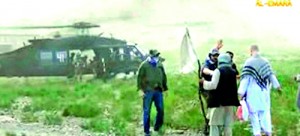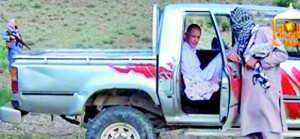Sunday Times 2
The story behind Obama’s decision to free Bergdahl
WASHINGTON, (Reuters) – For President Barack Obama, it seemed like the right thing to do, according to officials in his administration: Release five Taliban detainees at Guantanamo Bay prison in return for Bowe Bergdahl, the only known American prisoner of war in Afghanistan.
As a political firestorm engulfs the White House over that deal, Reuters interviews with current and former Obama administration officials involved in the negotiations, along with U.S. lawmakers, reveal how a close-knit circle in the Obama administration pursued the plan despite intense discord in the past over similar proposals.
The White House was ultimately persuaded to go ahead, in part, after Qatar agreed to take the Taliban detainees and said it would allow the United States to track the five men in the Gulf emirate. Under that arrangement, the United States installed extensive surveillance equipment to monitor their movements and communications, the officials said.
The deal, however, has caused an uproar among Republicans in Congress, who have questioned both the secrecy of the prisoner swap and the wisdom of freeing five Taliban prisoners. Some of Bergdahl’s former comrades have also accused him of deserting his post before his capture by the Taliban in June 2009. The Pentagon has declined to comment on those allegations.
While they were prepared for some political blowback, Obama administration officials said they felt the outcry would have been fiercer if in six months’ time, as the United States wraps up its mission in Afghanistan, it emerged that Obama had missed an opportunity to secure Bergdahl’s freedom.
The officials said Obama himself decided to make the swap and chose to broadcast the news on national television with Bergdahl’s parents at the White House. He wanted to send a clear signal to Americans that this was his decision and that he would uphold the maxim that the United States will always bring home all its troops from the battlefield, the officials said.
“The United States has always had a pretty sacred rule, and that is we don’t leave our men or women in uniform behind,” Obama told reporters in Warsaw on Tuesday.
Obama was aware that Bergdahl had been accused of desertion in Afghanistan. But the vitriolic nature of the criticism has surprised some in the Obama administration, the officials said.
Clinton’s doubts
The idea of swapping Bergdahl for Taliban detainees wasn’t new. It was first raised nearly four years ago and quickly ran into opposition in the administration and Congress.
“There were real big, serious issues here about whether we should exchange people, whether it would do any good” in terms of the broader Afghan peace effort, said David Sedney, a deputy assistant secretary of defence responsible for Afghanistan, who left the government in May 2013.
Sedney said he was sceptical of the deal while in government.
Officials involved in the diplomacy told Reuters that the then-Defence Secretary Leon Panetta and his predecessor, Robert Gates, along with the then-Secretary of State Hillary Clinton, initially raised strong objections to exchanging Bergdahl for the five Taliban detainees.
At first, Clinton was deeply sceptical of talks with the Taliban, but then supported a prisoner swap as a “confidence-building measure” that would help start peace talks between the Afghan government and the Taliban, the officials said. Those broader talks never fully got under way, and Saturday’s prisoner exchange was all that survived of that effort.
In public remarks this week, Clinton did not criticise Obama’s decision and said she supported the tradition of not leaving soldiers behind on the battlefield. It was Clinton who authorised the State Department-led talks with the Taliban, but “she set a high bar and insisted on strict conditions for any deal,” her spokesman Nick Merrill said. While Vice President Joe Biden was neutral on the prisoner swap, Obama and two top White House advisers, then-national security adviser Thomas Donilon and his deputy Denis McDonough, were all in favour, one official said. Donilon resigned a year ago, but McDonough went on to become Obama’s chief of staff.
Obama oversees what many U.S. officials and independent political analysts regard as one of the most insular national security teams in modern times. Key decisions — and often, information — are centralised at the White House with the president and a handful of aides, some of whom have been with him since his first presidential campaign.
Gates, Panetta and Clinton raised numerous issues regarding the sequencing of any prisoner release, the need to consult Congress and conditions for monitoring the Taliban detainees, two officials said.
Panetta was not immediately available for comment on that account, a firm that handles his communications said on Wednesday. A spokesman for Gates declined to comment.
An earlier version of the deal, which U.S. envoys discussed directly and indirectly with Taliban interlocutors, would have had two of the five Taliban released at the same time as Bergdahl, two officials said. The other three would be freed 90 days later.
The Taliban rejected that proposal, the officials said. Washington also balked at some Taliban demands, refusing requests that the five be allowed to travel outside Qatar post-release to Saudi Arabia for religious purposes and to Europe for medical care.
The Taliban’s chief negotiator, Tayeb Agha, noted at one point during the talks that Israel had traded more than 1,000 prisoners for a single Israeli soldier, Gilad Shalit, two officials said. The Taliban, he said, was asking only for five.
Talks with Qatar
The possibility of a deal emerged just after Obama returned from a lightning visit to Afghanistan on May 25, where he reiterated that the U.S. combat mission would conclude by year-end.
Clinching it was a phone call Obama made two days later, on May 27, with the emir of Qatar, Sheikh Tamim bin Hamad al-Thani, who said Qatari officials had agreed to measures to prevent at least an immediate return to the battlefield of the five Taliban prisoners, the officials said.
Those measures included the U.S. surveillance and a minimum one-year ban on the released detainees leaving Qatar.
On May 28, Obama met former Qatari emir Sheikh Hamad bin Khalifa al-Thani at the U.S. Military Academy at West Point in New York, where the president was making a speech. It is not clear whether they discussed the impending prisoner swap.
While a rescue operation to snatch Bergdahl — believed by the U.S. government to have been held in Pakistan’s tribal territories — was discussed in the years after his capture, current and former U.S. officials said the Obama administration never had enough reliable intelligence on the soldier’s location to stage a raid.
Moreover, the geopolitical costs of doing so climbed steeply after the May 2011 raid into Pakistan that killed al Qaeda chief Osama bin Laden, which sparked a rapid downturn in U.S.-Pakistani relations. Another raid into Pakistani territory would have severely damaged that relationship further.
 |
 |
| These screen grabs from recent video released on June 4 by Al-Emara, the official website of the Taliban, shows US Army Sergeant Bowe Bergdahl (R-back to camera and also in the pick up truck) at an undisclosed location in Afghanistan as he is being handed over to US forces (L) after five years in captivity. AFP | |

